2. 湖南省地质调查院, 长沙 410116;
3. 核工业北京地质研究院, 北京 100029
2. Hunan Institute of Geological Survey, Changsha 410116, China;
3. Beijing Research Institute of Uranium Geology, Beijing 100029, China
矿床是地质演化过程中特定阶段的产物,成矿时代对于矿床成因的确定、成矿过程的刻画及找矿方向的确定,具有十分重要的理论和实际意义。成矿年代学是深入探讨和研究矿床的成矿物质来源、成矿机理和成矿动力学背景等问题的关键因素,是研究金属成矿省历史演化的钥匙,对于揭示金属成矿省的演化规律具有重要意义(裴荣富和吴良士, 1993; Hu and Zhou, 2012; Hu et al., 2017)。
成矿年代学是矿床学研究中最为基本的内容,也是最为前沿的领域之一(胡瑞忠等, 2014)。铀矿不仅是一种非常重要的全球战略资源,而铀矿物也是U-Pb同位素年代学研究的主要对象。精细的铀矿年代学研究对于探讨铀矿床的成因和指导铀矿床的勘查工作都具有非常重要的意义。在世界范围内不同类型的铀矿床中,主要矿石矿物为晶质铀矿及其隐晶质变种沥青铀矿,少量为钛铀矿和铀石等矿石矿物,脉石矿物主要为石英、方解石、萤石、黄铁矿和辉钼矿等(Ruzicka, 1993; Hu et al., 1993, 2008, 2009)。早期一般利用与铀矿体有关的地质体(如地层、岩体等)相互关系间接推测铀矿床的成矿年龄。随着分析技术的进步和研究程度的深入,多采用直接、准确地测定铀矿物或与铀矿物共生的矿物年龄来确定铀矿床的成矿时代。晶质铀矿(沥青铀矿)是铀矿床最理想的定年矿物,它不仅是矿石矿物,更重要的是获得铀矿物的年龄直接代表了铀矿床的成矿年龄。此外,该矿石矿物年龄的获得避免了诸多金属矿床常采用与矿石矿物共生的脉石矿物、热液蚀变矿物及含铀副矿物的形成年龄,来限定成矿年龄所带来的不确定性(陆松年等, 1999; 赵葵东和蒋少涌, 2004)。
通常,铀矿床成因复杂,往往由于沥青铀矿在组成和结构上的固有特点,如以环带的胶状结构集合体形式产出(图 1),铀矿物颗粒极其细小、易蚀变成铀的次生矿物(图 2)及多期铀矿化作用相互叠加(图 3)等,导致传统的铀矿物溶样方法虽然测试精度较高,但样品的分选难度大。再者,铀的地球化学性质,决定铀极易在弱酸性和弱碱性热液条件下迁移,铀矿床中早期形成的铀矿物极有可能在后期地质事件中重新活化迁移,造成U或Pb的丢失。早在一个多世纪以前,Boltwood (1907)就利用铀矿中的U-Pb同位素体系进行年代学研究。过去有关铀矿年龄的测定多采用以热电离质谱为基础的同位素稀释法(TIMS)(Hills and Richards, 1976; Ludwig et al., 1987; Carl et al., 1992; Golubev et al., 2008; 石少华等, 2010; 田建吉等, 2010),该方法是目前U-Th-Pb定年中最灵敏、精度最高的。但它遇到的最大问题是,当测定的对象内部结构复杂、包含有多个年龄域的矿物时,所得到的数据往往是无地质意义的混合年龄。即使该技术发展到今天可以对单颗粒矿物进行同位素年代学分析,但实际应用中往往得到的铀矿化年龄也只是混合年龄。以致于不同学者对在同一个铀矿床测得的成矿年龄不同,甚至在同一个铀矿脉不同空间位置采集的铀矿物样品,也获得不同的年龄值。因而,用挑选沥青铀矿样品溶样的传统定年方法常常难以精确确定其形成年龄。

|
图 1 沥青铀矿呈环带胶状结构的集合体形式产出 Fig. 1 Pitchblende occurs as aggregation with banded colloidal structure |
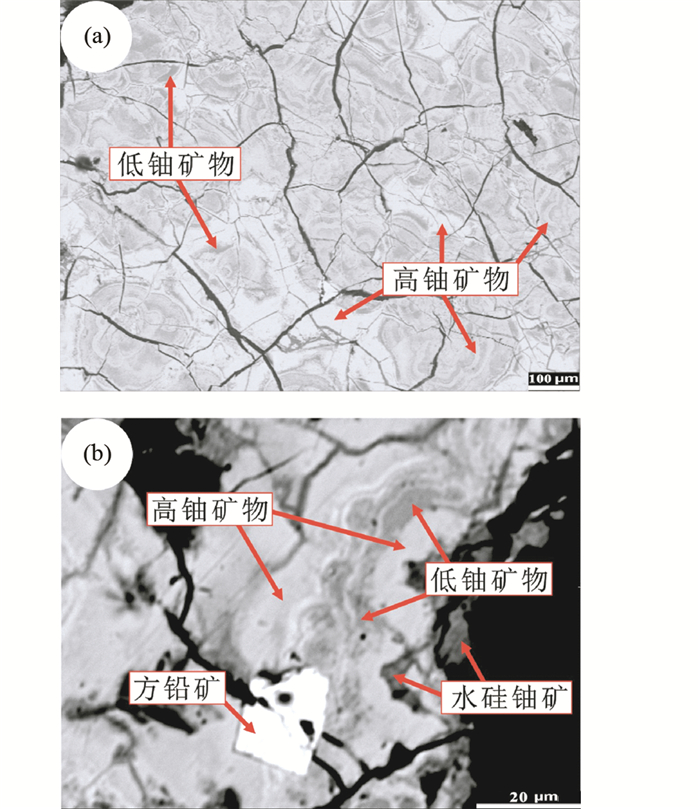
|
图 2 华南201矿床铀中铀矿物BSE图像显示在微区尺度上呈现不均一特性和次生蚀变作用 Fig. 2 BSE images show the heterogeneity and altered uranium mineral within micro-scale at the No.201 uranium deposit, South China |
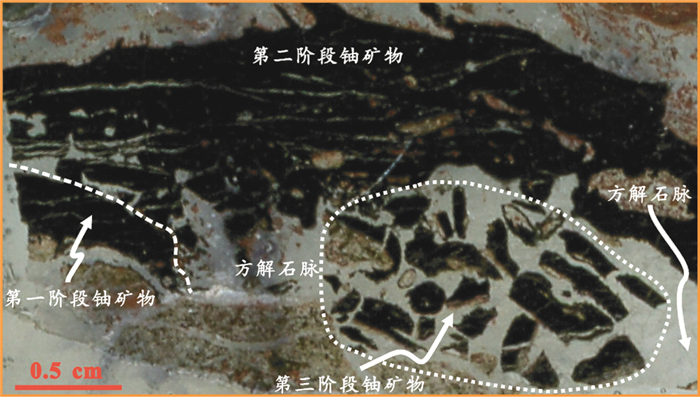
|
图 3 粤北仙石铀矿床中可见铀矿物在微区尺度上呈多期出现(据Luo et al., 2015b) Fig. 3 Multi-stage uranium minerals observed within micro-scale thin section from the Xianshi uranium deposit, South China (after Luo et al., 2015b) |
近二十年来,得益于微区原位测年技术的快速发展,含铀副矿物的年代学研究取得了巨大的进展。原位微区地球化学研究不仅避免了繁琐、耗时的湿法化学溶样过程,而且可以揭示单矿物微尺度元素/同位素的空间变化。目前,已经发展起来的微区原位测年方法有化学微区原位测年方法和同位素微区原位测年方法。微区化学测年方法有电子探针(EMP)、质子探针、X射线荧光探针技术等,同位素微区原位测年方法有离子探针和激光探针技术。尽管电子探针(EMP)具有极高的空间分辨率,可以获得颗粒较小含铀矿物的化学年龄(Bowles, 1990, 2015; Kempe, 2003; Cross et al., 2011; Förster et al., 2012; Pal and Rhede, 2013; Luo et al., 2015a, 2017),但这项分析技术对Pb的检测限低(100×10-6~500×10-6),导致测年精度有限。蓬勃兴起的SHRIMP/SIMS/LA-ICP-MS测试技术,以原位、高灵敏度和高空间分辨率等特点成为原位微区测试技术的研究热点。
本文通过分析目前常用的铀矿床定年方法的实用性与局限性,探讨当今铀矿床成矿年代学研究中存在的科学问题及如何准确可靠地获得铀矿床的成矿年龄。从铀矿床年代学的研究历程出发,笔者将铀矿床可行的主要定年方法概括为五种:(1)铀矿物U-Th-totalPb化学年龄;(2)铀矿物模式年龄;(3)铀矿物传统等时线年龄;(4)铀矿物伴生矿物年龄;(5)原位微区铀矿物U-Pb年龄。以下对上述五种重要定年方法的优缺点和应用进行概述和剖析,期望对今后铀矿床成矿年代学的研究提供帮助。
1 铀矿床年代学的研究现状和存在问题 1.1 铀矿物U-Th-totalPb化学年龄Boltwood (1907)最早根据U的放射性衰变定律,利用晶质铀矿中U和Pb含量计算化学年龄,开启了U-Pb年代学研究的先河。随后,Holmes and Strutt (1911)进一步发展了铀矿物化学年龄计算方法。但限于当时的分析技术条件,直到20世纪60年代后,才开始大量应用到各种不同地质时期花岗岩中晶质铀矿和不同类型铀矿床中铀矿物的年龄测定(Ranchin, 1968; Cameron-Schiman, 1978; 张昭明, 1982; Parslow et al., 1985; Bowles, 1990, 2015; Kempe, 2003; Cross et al., 2011; Votyakov et al., 2011, 2013; Förster et al., 2012; 郭国林等, 2012; 葛祥坤, 2013; Luo et al., 2015a, 2017; 胡瑞忠等, 2015)。
电子探针U-Th-Pb微区化学测年技术以放射性核素的衰变理论为基础,通过电子探针准确测量矿物中的U-Th-totalPb含量,经数据处理并最终计算出矿物的年龄。众所周知,天然形成的晶质铀矿、锆石和独居石等矿物中一般都含有一定量的天然放射性元素232Th、235U和238U,经过一系列α和β衰变后最终形成稳定的Pb同位素。晶质铀矿/沥青铀矿(UO2)中仅含有U和O组分,是最为理想的获得化学年龄的矿物。在天然铀矿物样品的研究中,基于不同方法对化学年龄进行计算时,通常都需要满足以下前提条件:(1)初始Pb含量极低,可忽略不计;(2) U-Th-Pb体系处于封闭状态;(3) Pb组分仅仅来自U和Th的放射性衰变。此外,电子探针化学分析中识别出的含蚀变矿物化学组分的数据应被剔除。因而,通过U和Th衰变产生的Pb,公式如下:

|
(1) |
此公式假设已知沥青铀矿或晶质铀矿中U、Th和Pb组分,仅年龄未知。U、Th和Pb为所占测定元素比例的原子百分数,U中238U和235U分别占99.276%和0.7196%。第一项为238U衰变为206Pb,衰变系数为λ1=0.000155125Ma-1。第二项为235U衰变为207Pb,衰变系数为λ2=0.00098485Ma-1。第三项为232Th衰变为208Pb,衰变系数为λ3=0.000049475Ma-1。这些衰变常数引自Jaffey et al. (1971)。在公式(1)中,衰变常数为Ma-1,因而获得的年龄t为Ma。然而,该公式事实上很难直接计算年龄t。
公式(1)中,238U与235U含量相比,在U总含量中占绝对优势,因而第一项获得的主要是由238U衰变形成的绝大部分的206Pb。此外,沥青铀矿中Th很低,232Th衰变为208Pb形成的Pb占总Pb含量中很少。因此,在忽略Th和235U对Pb的贡献时,公式(1)种第一项可获得大概年龄t:

|
(2) |
公(2)式中U和Pb总量为原子百分比,为简化电子探针数据的计算,依据238U和235U及206Pb和207Pb的丰度,可简化为:

|
(3) |
Ranchin (1968)提出了一个类似的经验公式,其中U、Th和Pb为元素质量百分数,年龄t的单位为Ma。

|
(4) |
Cameron-Schiman (1978)通过U和Th的放射性衰变提出了如下经验公式,其中U、Th和Pb为原子百分数,获得年龄t的单位为年。

|
(5) |
我国学者张昭明(1982)也提出过相似的经验公式,其中U、Th和Pb为元素质量百分数,结果的单位为Ma。

|
(6) |
上述各解决方案中,均为简化公式(1)得到,虽可得到大概年龄,但年龄结果往往偏大。之后,Bowles (1990)提出将简化公式(2)获得的估算年龄t,通过迭代方式将年龄t以10Ma递减,获得的年龄代入公式(1)中计算Pb含量。当公式(1)中计算的Pb含量与电子探针测定的Pb成分值接近时,再将年龄递减值降为1Ma,将年龄t代入公式(1)中进行反复迭代,直至计算的Pb含量与测定值一致,最终获得的年龄更接近铀矿物的形成年龄。利用Isoplot软件计算可得到铀矿物表观年龄的加权平均值。
除上述方法外,不同研究者也尝试了其他铀矿物化学定年方法(Kempe, 2003; Cross et al., 2011; Votyakov et al., 2011, 2013; Förster et al., 2012; 郭国林等, 2012; 葛祥坤, 2013; Bowles, 2015)。但这些铀矿物化学年龄法基本都依赖于铀矿物中所测定的U-Th-Pb或其对应氧化物化学组分。随着铀矿物标样的确定,铀矿物岩相学的系统研究和化学成分测试精度的不断提高,国内外已有许多利用化学年龄成功获得铀矿物和/或铀矿床精确年龄的实例(Bowles, 1990, 2015; Kempe, 2003; Cross et al., 2011; Votyakov et al., 2011, 2013; Förster et al., 2012; 郭国林等, 2012; Pal and Rhede, 2013; Luo et al., 2015a, 2017)。
笔者通过对比上述不同经验公式的计算结果,发现利用公式(4)和(5)获得华南201铀矿床中沥青铀矿化学U-Th-totalPb年龄(图 4)与ID-TIMS测定沥青铀矿206Pb/238U年龄70.3±0.5Ma(赵溥云等, 1995)及SIMS沥青铀矿U-Pb年龄73.3±4.7Ma(见后文图 13)在误差范围内一致。对于极其年轻的地质样品,因初始Pb含量极低,可忽略不计,且在U-Pb同位素体系封闭条件下,可认为Pb仅来源于U和Th的衰变。在此情况下,通过公式(5)获得的化学年龄(表 1和图 5a)与SIMS铀矿物U-Pb测定年龄结果(表 2)在误差范围一致(Luo et al., 2017; 图 5b)。骆金诚(2015)对于上述不同化学年龄方法的实用性和准确性,已做了较为详细的探讨,在此不再赘述。

|
图 4 Multi-stage uranium minerals observed within micro-scale thin section from the Xianshi uranium deposit, South China (after Luo et al., 2015b) Fig. 4 Single U-Th-Pb pitchblende chemical age using Cameron-Schiman (a) and Ranchin (b) formula and weight age diagrams for the No.201 uranium deposit, northern Guangdong, South China (after Luo, 2015) |
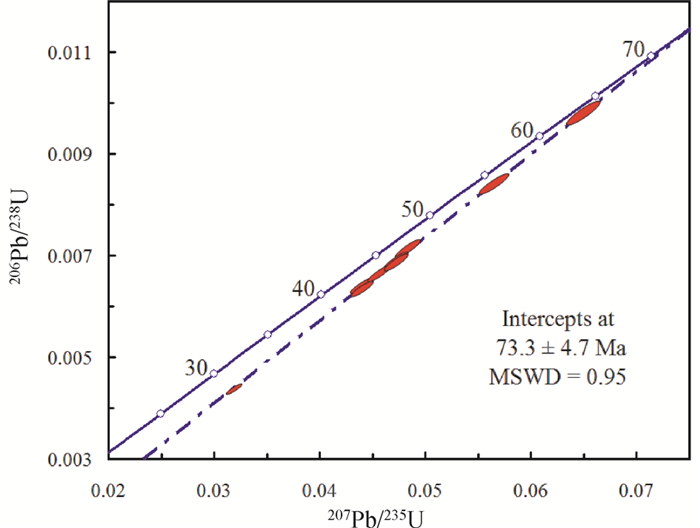
|
图 13 利用LAMNH铀矿标样校正GBW04420铀矿标准物的SIMS U-Pb年龄图 Fig. 13 U-Pb concordia diagram of SIMS U-Pb uraninite standard GBW04420 using LAMNH uraninite standard as internal standard for calibration |
|
|
表 1 桂北孟公界花岗岩型铀矿床沥青铀矿电子探针测定结果(wt%)(据Luo et al., 2017) Table 1 EMP chemical concentrations (wt%) of pitchblendes from the Menggongjie granite-hosted uranium deposit, northern Guangxi, South China (after Luo et al., 2017) |
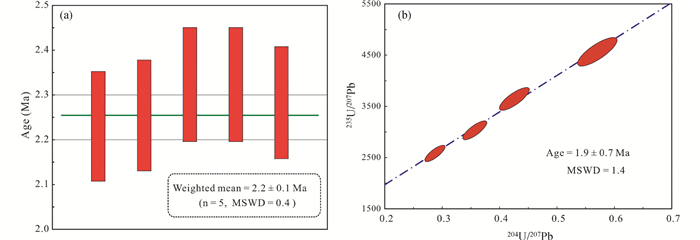
|
图 5 桂北孟公界花岗岩型铀矿床沥青铀矿U-Th-Pb化学年龄图(a)和SIMS U-Pb年龄图(b)(据Luo et al., 2017) Fig. 5 Pitchblende U-Th-Pb chemical age (a) and SIMS U-Pb age (b) diagrams for the Mengongjie granite-hosted uranium deposit, northern Guangxi, South China (after Luo et al., 2017) |
|
|
表 2 桂北孟公界花岗岩型铀矿床沥青铀矿SIMS U-Pb同位素及标样LAMNH测试结果 Table 2 SIMS U-Pb isotopic data for pitchblendes from the Menggongjie granite-hosted uranium deposit, northern Guangxi, China and corrected using LAMNH standard (after Luo et al., 2017) |
电子探针测年方法的分辨率极高(束斑可达1μm),不仅适用于矿物颗粒极小的地质样品,也有利于识别记录多个地质事件的铀矿物(Bowles, 1990; Luo et al., 2015a; 图 6)。因此,对于某些特殊的地质样品,可以获得意想不到的年龄信息。但化学年龄方法的缺点在于测定铀矿物单点年龄的过程中,难以识别铀矿物中U、Th和Pb组分的获得或丢失,无法区分沥青铀矿中普通Pb和来自U或Th放射性成因Pb。此外,该方法对Pb的检测限低(100×10-6~500×10-6),导致测定的年龄精度有限。因获得的年龄数据往往与U-Pb同位素方法获得的年龄相差较大,而应用得越来越少。因此,电子探针化学测年应与其它方法得到的年龄结果进行对比研究。

|
图 6 桂北沙子江花岗岩型铀矿床中两期沥青铀矿U-Th-Pb化学年龄和加权平均年龄图(据Luo et al., 2015a) Fig. 6 Two stages of pitchblende U-Th-Pb chemical age and weight age diagrams for the Shazijiang granite-hosted uranium deposit, northern Guangxi, South China (after Luo et al., 2015a) |
Boltwood (1907)首次利用铀矿物U-Pb同位素体系开展年代学研究。随着质谱仪的改进,Nier (1935)精确测定了U-Pb同位素组成,奠定了现代U-Pb同位素年代学研究的基础。模式年龄是在一定的前提下,计算单个铀矿物样品从源区分离至今的时间。早在20世纪50年代起就有较多关于铀矿床U-Pb同位素模式年龄的报道(Miller and Kulp, 1958; Ludwig, 1978)。在我国华南地区铀矿床研究中也采用了大量铀矿物U-Pb同位素的模式年龄(杜乐天, 1982; 徐达忠等, 1999; 吴烈勤等, 2003及参考文献; 邓平等, 2003)。这类年龄数据常存在以下问题:(1)采自同一矿床甚至明显为同期脉体的多个铀矿物样品,往往会获得多个分散的模式年龄结果;(2)同一铀单矿物所获得的三个模式年龄基本都不一致,且往往表现为t206/238 < t207/235≤t207/206。为了从模式年龄数据中获得有价值的铀成矿年龄信息,Ludwig (1978)总结了造成铀矿物模式年龄不一致性原因:(1)开放体系导致U的一个或多个子体同位素迁移;(2)大量早期放射性成因Pb的混入。因此,如何有效甄别铀矿物形成后是否处在一个封闭的体系,如何更加合理有效的测定铀矿床的成矿年龄,已成为了铀矿地质工作者不断研究和探索的课题。
在模式年龄计算过程中,合理扣除初始Pb至关重要。一般通过间接方法确定,即测定与被测铀矿物样品近于同时形成的方铅矿、黄铁矿等矿物的Pb同位素值。这类矿物U、Th含量很低,自结晶后放射性成因Pb增长可以忽略不计,因而可作为被测样品的初始Pb同位素组成(李志昌等, 2004)。通常,更简便直接的做法是在综合各类地质资料基础上,大致估计铀成矿年代,结合已有铅同位素演化模型确定其初始Pb同位素组成(Ludwig, 1979)。当铀矿物样品的204Pb含量异常低时,206Pb/204Pb值极大,初始Pb扣除对计算结果影响非常小。李志昌等(2004)则给出了经验性的建议,当206Pb/204Pb值大于1000时,所得模式年龄基本能够代表成矿年龄。
夏毓亮等(2003)认为铀矿物中普遍存在U-Ra不平衡现象,在进行年龄计算之前应该通过U-Ra平衡系数修正样品铀含量,从而获得不受近代铀迁移或富集影响的更符合实际情况的成矿年龄。石少华等(2010)对模式年龄与真实年龄关系进行了计算,表明合理的初始Pb扣除可以获得与真实年龄较为一致的模式年龄。由此可见,铀矿物U-Pb同位素模式年龄的研究为确定铀矿床的成矿年龄,探讨铀成矿规律具有重要作用。但实际应用中仍存诸多问题,如初始Pb扣除采用的方案中,(1)方铅矿及黄铁矿等与铀矿物共生的脉石矿物成因复杂,难以保证是与被测铀矿物同源且同时形成;(2)各类Pb同位素演化模型都是针对某一地区、特定构造环境或综合全球数据的平均模型。因此,不论采取何种模式假设前提来确定初始Pb,都可能偏离真实情况。此时,可利用206Pb/204Pb值来判断模式年龄的可靠性,其值越大所获得的模式年龄越接近真实年龄。反之,所获得的模式年龄无实际地质意义。当扣除初始Pb值小于矿物实际初始Pb值时,所获得模式年龄将大于真实年龄,甚至会出现成矿年龄大于赋矿围岩年龄的假象;当扣除初始Pb值大于矿物实际初始Pb值时,所获得的模式年龄则小于真实年龄。因此,由于初始Pb的扣除存在极大不确定性,目前基本已经不再应用该方法。
1.3 铀矿物传统等时线年龄Wetherill (1956)最先提出U-Pb一致曲线图,为U-Pb同位素方法获得精确年龄做出了重要贡献。本文讨论的铀矿床传统U-Pb等时线年龄法,是指采用TIMS稀释法测定挑选矿物中U和Pb同位素比值,拟合不同样品的U-Pb同位素数据而获得等时线年龄。该方法不需要考虑扣除初始Pb带来的不确定因素,也解决了模式年龄的不一致问题。等时线法中U-Pb一致曲线的交点年龄可给出铀矿物的结晶年龄或/和导致铀矿物中U和Pb同位素得失的相应地质事件的年龄。理论上讲,一组同源且同结晶的矿物,在同一时间遭受同一地质事件影响的样品,U-Pb同位素数据应落在同一等时线上。但样品采集不合理时,往往会出现数据点过于分散或聚集一团,无法拟合出等时线或拟合出的等时线误差较大。目前,国内外用此方法成功获得铀矿床准确年龄的实例并不多。为此,笔者针对几种成功拟合铀矿床U-Pb等时线年龄的典型范例,重点探讨不同矿物/矿物组合的选样方案:
(1) 沥青铀矿和/或晶质铀矿等单矿物样品:通常要求沥青铀矿或晶质铀矿样品纯度高,且为了获得的年龄数据点分布合理,理论上单个样品U-Pb同位素的组成应有差异。该方案拟合出的年龄值可信度高,研究的典型实例也相对较多(Ludwig et al., 1981, 1982, 1987; Cunningham et al., 1982; 黄世杰等, 1985; 徐伟昌等, 1988; Min et al., 1999; 夏毓亮等, 2003; 夏毓亮和韩军, 2008; 邓平等, 2003; 范洪海等, 2003; 张国全, 2008; 黄国龙等, 2010; 石少华等, 2010)。如徐伟昌等(1988)对广西铲子坪铀矿床进行沥青铀矿U-Pb同位素年代学的研究中,基于不同地层中沥青铀矿样品模式年龄的不同将其分为两组(表 3),分别拟合等时线获得两组不同的年龄。由于模式年龄是通过单阶段Pb同位素演化模式计算获得,其值易受初始Pb同位素值的扣除和样品中U和Pb含量的影响。石少华等(2010)提出这样将表观年龄人为分组欠妥,并对数据重新拟合计算获得一条较好的等时线年龄74.1±9.9Ma(图 7a),该年龄可能代表了铲子坪铀矿床主成矿期的年龄。此外,石少华等(2010)也利用该方法获得沙子江铀矿床中沥青铀矿等时线年龄53.0±6.4Ma(表 4和图 7b),并解释为该矿床最小的成矿年龄。该样品的选取方案,通常需要采集同期铀矿脉走向或倾向上间隔的样品,且挑选的铀矿物样品纯度高,不受次生铀矿物的影响。但往往由于铀矿床的成矿作用复杂,多期铀矿化作用叠加形成的铀矿脉很容易在产状上表现出同期、甚至同脉的假象,因而样品采集难度大。如同一矿脉的铀矿物,也可能在微小区域内呈现多期铀矿化叠加的特性(Luo et al., 2015b; 图 3)。因而,对于含多期铀矿化作用叠加的铀矿床而言,该方法测定的结果难以代表铀成矿作用的真实年龄。
|
|
表 3 桂北铲子坪铀矿床沥青铀矿U-Pb同位素测试结果(据徐伟昌等, 1988) Table 3 U-Pb isotope compositions of pitchblendes from the Chanziping uranium deposit, northern Guangxi, South China (after Xu et al., 1988) |

|
图 7 桂北铲子坪铀矿床(a)和沙子江铀矿床(b)沥青铀矿U-Pb等时线年龄图(据石少华等, 2010) Fig. 7 U-Pb isochron age diagrams of pitchblende from the Chanziping (a) and Shazijiang (b) uranium deposit, northern Guangxi, South China (after Shi et al., 2010) |
|
|
表 4 桂北沙子江铀矿床沥青铀矿U-Pb同位素测试结果(据石少华等, 2010) Table 4 U-Pb isotope compositions of pitchblendes from the Shazijiang uranium deposit, northern Guangxi, South China (after Shi et al., 2010) |
(2) 铀矿石样品:当矿石品位低、铀矿物粒度过小且很难挑出时,常采用这一方案。由于成矿过程中一定范围内同位素基本能够达到均一化,因此铀矿石样品等时线年龄的方案仍在使用(Ludwig et al., 1981; 夏毓亮和张彩娥, 1984; 黄世杰等, 1985; 徐伟昌等, 1988; 田建吉等, 2010; 表 5和图 8)。但该方案中由溶液法获得的同位素,易受围岩及后期蚀变U和/或Pb丢失的次生铀矿物同位素体系的影响,导致获得的年龄往往存在偏差:①混染了围岩中含铀副矿物同位素比值,所测年龄明显早于原生铀矿形成年龄;②原生铀矿物极不稳定,混杂后期蚀变的次生铀矿物的同位素时,获得的混合年龄要小于原生铀矿化时代。因此,该方案往往得到同位素的混合比值,无法获得等时线年龄或获得假等时线年龄,无实际地质意义。对于精确限定铀矿床成矿年代的作用还有待商榷。
|
|
表 5 赣杭火山岩铀矿带中661矿床铀矿石U-Pb同位素数据(据田建吉等, 2010) Table 5 U-Pb isotope compositions of uranium ores from the No.661 uranium deposit located in the Gan-Hang volcanic-hosted uranium belt, South China (after Tian et al., 2010) |
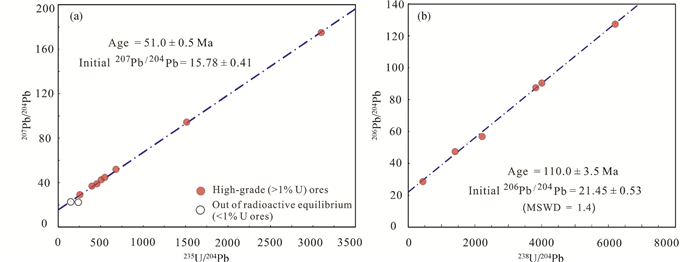
|
图 8 美国华盛顿地区Midnite矿床(a, 据Ludwig et al., 1981)和赣杭火山岩铀矿带中661矿床(b, 据田建吉等, 2010)铀矿石U-Pb等时线年龄图 Fig. 8 U-Pb isochron age diagrams of uranium ores from the Midnite mine, Washington, USA (a, after Ludwig et al., 1981) and No.661 uranium deposit located in the Gan-Hang volcanic-hosted uranium belt, South China (b, after Tian et al., 2010) |
(3) 沥青铀矿和/或晶质铀矿等铀单矿物+方铅矿和/或黄铁矿等伴生矿物样品(Hills and Richards, 1976; Zartman and Smith, 2009):理论依据是几种伴生矿物U-Pb同位素体系计时同时开启,该方案是为了解决拟合等时线时,铀单矿物样品数据点易聚集而采用,这样大大提高了等时线拟合的成功率。其前提是根据野外地质工作基础,采用与沥青铀矿和/或晶质铀矿同源且同期共生的脉石矿物,如方铅矿或黄铁矿等矿物样品。理论上,该样品的选取方案是获得传统等时线年龄中最理想的。Zartman and Smith (2009)利用该方法获得了铀矿化作用的理想年龄(表 6和图 9)。但野外产状上与铀矿物共生的方铅矿和/或黄铁矿等脉石矿物成因复杂,实际采样中很难保证它们与伴生铀矿物的U-Pb体系同源且同期,因而成功利用该方法获得铀矿化年龄的实例极少。
|
|
表 6 美国Sunshine铀矿床中含铀碧玉脉中锆石、钛铀矿和黄铁矿U-Pb同位素龄数据(据Zartman and Smith, 2009) Table 6 U-Pb isotopic compositions of zircon, brannerite, pyrite from a jasperoid vein, Sunshine Mine, USA (after Zartman and Smith, 2009) |
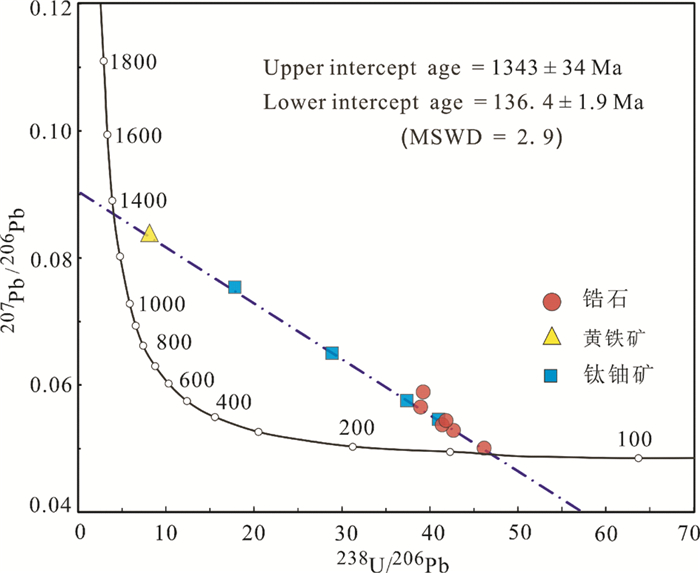
|
图 9 美国爱达荷州Sunshine铀矿床中含铀碧玉脉中锆石、钛铀矿和黄铁矿238U/206Pb-207Pb/206Pb谐和年龄图(据Zartman and Smith, 2009) Fig. 9 238U/206Pb vs. 207Pb/206Pb concordia diagram for U-Pb zircon, brannerite and pyrite data from uranium-bearing jasperoid vein at the Sunshine mine, Idaho, USA (after Zartman and Smith, 2009) |
铀矿床中铀矿物往往以带环带的胶状结构集合体形式产出(图 1),矿物颗粒极为细小且化学组分很不均一(图 2),即使在微小区域也可见多期叠加(图 3)。鉴于铀矿物本身在组成和结构上的固有特点,通常难以用挑选沥青铀矿样品溶样的传统方法精确确定其形成年龄。加之,难以获取原位微区分析标准样品,目前铀矿物微区测年方法的应用相对有限。
当上述方法在实际研究中不易获得准确的年龄时,可测定与铀矿物伴生矿物的年龄。已有研究者成功地利用与沥青铀矿或晶质铀矿伴生的方解石、辉钼矿及热液蚀变云母类等矿物(图 10),间接获得铀矿床的矿化年龄。如陈恒等(2012)采用方解石Sm-Nd法(表 7),获得赣南6722花岗岩型铀矿床中与沥青铀矿伴生方解石的形成年龄(图 11)。李月湘(1990)利用热液矿化蚀变过程中形成的水云母40Ar-39Ar年龄法,获得粤北201铀矿床中热液蚀变的年龄为71.6±1.6Ma,该年龄与SIMS沥青铀矿U-Pb年龄73.3±4.7Ma(笔者未发表数据)基本一致。Förster et al. (2012)采用与晶质铀矿伴生的辉钼矿Re-Os法和晶质铀矿U-Th-totalPb化学年龄法,获得德国Königshain岩体中辉钼矿与晶质铀矿的结晶年龄分别为327±1Ma和328.6±1.9Ma,且两种不同方法测定的年龄在误差范围内一致。这些研究表明,当铀矿物直接定年方法受到特定分析条件的制约时,某些与铀矿物共生的矿物也可用来限定铀矿化的成矿时代,如热液蚀变过程中的云母类矿物、绿泥石和伊利石的Ar-Ar定年及与铀矿物伴生的辉钼矿和黄铁矿的Re-Os年龄法。但在特定铀矿床的研究中,往往缺失辉钼矿,或难以获得与铀矿物共生的同期黄铁矿和方解石等脉石矿物。同时,铀矿化过程中热液蚀变形成的云母类矿物、绿泥石和伊利石等矿物Ar-Ar体系易受后期热事件的干扰,会导致这些矿物在铀矿化过程中形成的Ar在遇到后期地质热事件时发生Ar丢失,进而影响获得蚀变矿物年龄的准确性。因此,铀矿物伴生矿物定年法在铀矿床的实际应用中并不常见,当其他方法的应用受到限制或需多种定年方法相互印证时,仅少量研究者尝试该定年方法。
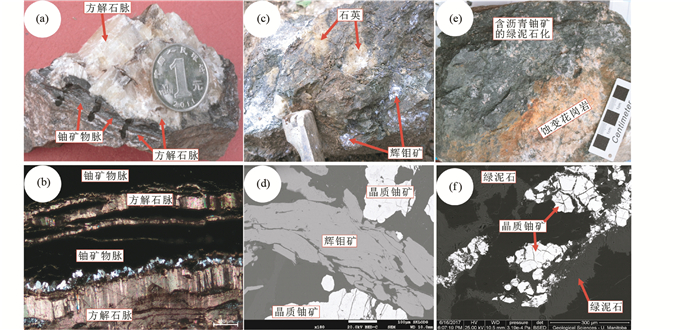
|
图 10 不同铀矿化类型中方解石、辉钼矿和绿泥石矿物与铀矿物伴生的手标本(a、c、e)、光学显微镜(b)及背散射图像照片(d、f) (a、b)花岗岩型铀矿床中铀矿物脉与方解石脉伴生;(c、d)混合岩化带中晶质铀矿与辉钼矿共生;(e、f)蚀变花岗岩中观察到绿泥石化带中形成的沥青铀矿 Fig. 10 Hand specimen (a, c, e), microscope (b) and BSE (d, f) images showing calcite, molybdenite and chlorite associated with uranium minerals in various types of uranium minieralizaiton (a, b) uranium mineral vein associated with calcite vein in the granite-hosted uranium deposit; (c, d) uraninite occurs with molybdenite in the migmatization zone; (e, f) pitchblende occurs within chlorite zone in altered granite |
|
|
表 7 赣南6722花岗岩型铀矿床方中解石Sm-Nd同位素分析结果(据陈恒等, 2012) Table 7 Sm-Nd isotopic compositions of calcites from the No.6722 granite-hosted uranium deposit, southern Jiangxi Province, South China (after Chen et al., 2012) |
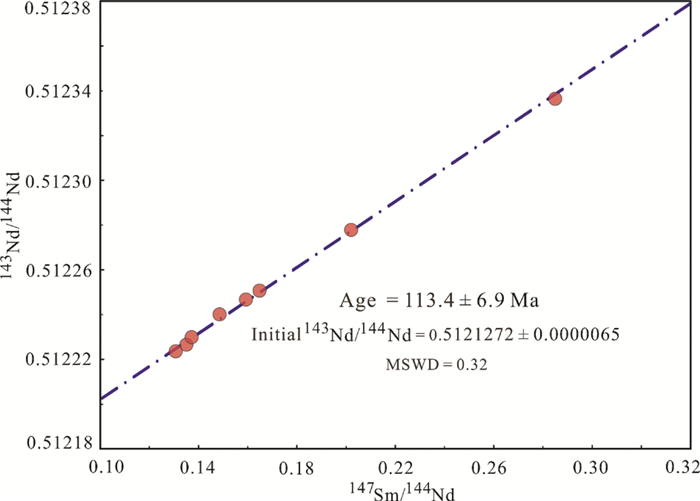
|
图 11 赣南6722花岗岩型铀矿床方中解石Sm-Nd等时线年龄图(据陈恒等, 2012) Fig. 11 Sm-Nd isochron age of calcite from the No.6722 uranium deposit, southern Jiangxi Province, South China (after Chen et al., 2012) |
锆石、独居石和磷灰石等普通含铀副矿物的原位微区U-Pb同位素年代学研究已相当成熟。前人对铀矿物原位微区分析也进行了大量研究,尝试了不同的分析方法(Meddaugh, 1983; Holliger and Cathelineau, 1986, 1987, 1988; Fourel et al., 1988; Holliger, 1991, 1994; Cathelineau et al., 1990; Eikenberg, 1991; Förster and Haack, 1996; Fayek et al., 2000, 2002a, b; Chipley et al., 2007; Decrée et al., 2011; Sharpe and Fayek, 2011, 2016; 邹东风等, 2011; 宗克青等, 2015)。早期研究发现,测试中仪器质量分馏引起Pb2+和UO2+二次离子比值存在较大偏差,进而利用电子探针获得铀矿物样品中化学成分的Pb/U比值,并采用该比值对测试样品的U-Pb同位素进行修正。随后,Fayek et al. (2002a)发现铀矿物化学成分的细微差异都会导致Pb2+和UO2+二次离子比值的巨大偏差,利用测定Pb/U化学成分的比值来校正U-Pb同位素比值的方法最终会导致U-Pb同位素年龄存在很大的不确定性。Fayek et al. (2002b)在研究SIMS测定206Pb/238U和207Pb/235U比值与真实值之间的内在关系时,发现不同Pb/U同位素比值与样品中PbO成分含量的变化存在明显的函数协变关系,并给出了真实值与测量值之间的经验校正公式。因而,利用SIMS微区原位方法精确获得铀矿物U-Pb年龄成为可能,也使该研究成为铀矿床年代学研究领域中的国际前沿。
由于天然铀矿物极不均一(图 1-图 3),因而难以获得微区原位定年的铀矿物标准物质。Chipley et al. (2007)利用LA-ICP-MS测定铀矿物U-Pb同位素时,尝试采用锆石标准物质91500为外标对铀矿物进行U-Pb同位素比值校正,测试的四个铀矿床样品均未得到谐和年龄,但不一致线上交点年龄与前人利用TIMS铀矿物溶样方法获得U-Pb年龄结果在误差范围内一致。进而,Chipley et al. (2007)提出锆石和铀矿物具有类似的U-Pb同位素分馏行为,认为利用锆石对铀矿进行校正是可行的。事实上,不同学者采用传统沥青铀矿U-Pb溶样方法获得同一矿床的成矿年龄范围较大,导致无法识别利用锆石校正后测定的年龄与TIMS溶液法获得年龄的差异。宗克清等(2015)发现锆石标样与铀矿物在化学组分上的差异极大,因基体效应引起的仪器质量分馏,会直接影响最终测定结果的准确性,误差可达17%。早期,国内仅邹东风等(2011)利用类似的方法对下庄335铀矿床进行过尝试,尽管所获得的年龄在U-Pb谐和图上呈现出较高的谐和度,但年龄数据总体分布范围较大70~96Ma。宗克清等(2015)采用fs-LA-ICP-MS分析铀矿标准物质GBW04420的U-Pb年龄,利用锆石标准物质M257做外标对铀矿物标准物质GBW04420校正得到的谐和年龄为82.2±0.5Ma(图 12),大于ID-TIMS测试的206Pb/238U推荐年龄(70.3±0.5Ma; 赵溥云等, 1995)。故利用锆石标样对铀矿物进行U-Pb同位素比值校正的方法还需进一步研究。

|
图 12 利用锆石标样M257作为外标对fs-LA-ICP-MS分析铀矿标准物质GBW04420的数据进行校正得到的U-Pb年龄谐和图(据宗克清等, 2015) 铀矿标准物质GBW04420的206Pb/238U年龄和U-Pb同位素推荐值赵溥云等(1995) Fig. 12 U-Pb concordia diagram of fs-LA-ICP-MS U-Pb uraninite standard GBW04420 using zircon standard M257 as external standard for calibration (after Zong et al., 2015) The 206Pb/238U age and U-Pb isotopic compositions of uraninite GBW04420 from Zhao et al. (1995) |
Sharpe and Fayek (2011)利用SIMS测得铀矿物LAMNH标样的U-Pb同位素值与TIMS获得的LAMNH同位素真实值进行对比,通过公式(7)获得校正系数:

|
(7) |
其中,RSIMS为SIMS直接所测得的同位素值(R=206Pb/238U, 207Pb/235U和207Pb/206Pb),RTRUE为TIMS所测定的LAMNH标样的公认/或真实值。在同一分析阶段中,为获得样品的“真实”同位素比值,需要利用校正系数α来校正SIMS测定样品的同位素比值。目前,尽管LAMNH铀矿是目前国际上少有的天然铀矿标准物质,但该方法已有较多应用于不同类型及不同时代铀矿床年代学的成功范例(Sharpe and Fayek, 2011; Bergen and Fayek, 2012; Luo et al., 2015b, 2017; Sharpe et al., 2015)。且笔者最近利用该方法获得GBW04420铀矿标准物质的SIMS U-Pb年龄为73.3±4.7Ma(笔者未发表数据)(图 13),与推荐的TIMS测试的206Pb/238U年龄70.3±0.5Ma在误差范围内一致,也进一步说明该方法的可靠性与实用性。
此外,Sharpe and Fayek (2016)研究发现不同PbO成分含量的铀矿物基底效应不同,并基于铀矿物206Pb/238U和207Pb/235U同位素比值与样品PbO含量之间的协变关系,建立完善了三个铀矿物标样序列,进而利用不同标样的Pb/U同位素比值与标样PbO百分含量之间的函数协变关系,来校正不同PbO组分的铀矿物测试样品。这是迄今为止,国际上对铀矿物原位微区U-Pb同位素方法最全面深入的解析和研究。
在实际研究中,由于铀矿物颗粒通常较小,往往以环带的胶状结构集合体形式产出(图 1),且化学成分也极不均一(图 2)。当铀矿物颗粒具有多期性或经后期热液改造叠加(图 3; Luo et al., 2015b, 2018),铀矿物会变得更加复杂,将极大的影响传统定年方法的准确性。铀矿物原位微区U-Pb同位素方法结合了传统U-Pb等时线年龄及原位微区分析技术的优点。可根据矿物的岩相学特征直接在光薄片下进行测试,不仅避免了矿物间的混染,而且也可在微小区域进行多期次铀矿物分析(图 3和图 14; Luo et al., 2015b)。与传统拟合等时线年龄方法相比,原位微区方法克服了铀矿床年代研究中选取样品困难的问题,避免了铀的单矿物分选过程中可能造成的混染,且完全保留了矿物共生组合的特征。铀矿物U-Pb原位微区分析方法的重大突破,使得原位微区铀矿物U-Pb方法在确定成矿时代上显示出了其他方法无法比拟的优越性。铀矿物原位微区分析最大的难点在于标准样品的获得。目前世界上通用的铀矿标准物质极其缺乏,这严重限制了铀矿物SIMS和/或LA-ICP-MS U-Pb测年方法的应用与完善。
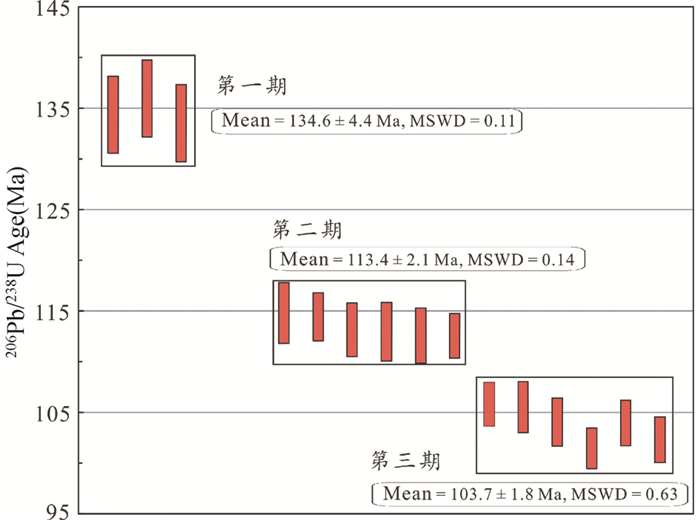
|
图 14 仙石铀矿床SIMS铀矿物U-Pb年龄分布图(据Luo et al., 2015b) Fig. 14 Age distribution of uranium mineral from the Xianshi uranium deposit determined by in-situ SIMS U-Pb (after Luo et al., 2015b) |
目前,国内很多铀矿床的定年工作受野外地质观察的准确性、成矿期次、成矿阶段的划分和定年方法的制约,获得的铀矿床成矿时代往往比较混乱。以我国华南粤北地区仙石(339)和棉花坑(302)花岗岩型铀矿床为例。邓平等(2003)根据成矿阶段的划分选取仙石铀矿床中早期角砾状沥青铀矿和晚期脉状沥青铀矿,进行传统铀矿物U-Pb溶液法测试,得到~125Ma和81Ma两组年龄;而Luo et al. (2015b)采用SIMS铀矿物U-Pb定年方法,在详细的铀矿物岩相学研究基础上(图 3),获得仙石铀矿床有三组矿化年龄135±4Ma、113±2Ma和104±2Ma(表 8和图 14),且与区域上基性脉岩的侵位年龄相对应。棉花坑矿床(302)是我国华南最大的花岗岩型铀矿床,已对该铀矿的成矿年龄进行了较多的研究。以往主要采用传统的沥青铀矿U-Pb溶液方法,如张国全(2008)获得棉花坑铀矿床中早期角砾状矿石和猪肝色硅化碎裂花岗岩型“红化”矿石的矿化年龄分别在~127Ma和~54Ma;而黄国龙等(2010)对采自该铀矿床不同部位的沥青铀矿进行传统沥青铀矿U-Pb和Sm-Nd等时线法,测定棉花坑铀矿床的成矿年龄~70Ma。最近,Zhong et al. (2018)利用最新的fs-LA-ICP-MS沥青铀矿U-Pb方法,获得年龄为59.5±1.0Ma和60.0±0.5Ma。统计发现该矿床不同部位或同一部位不同样品的U-Pb年龄结果都存在很大差异,主要集中在54~91Ma和114~157Ma两个阶段内(金景福和胡瑞忠, 1985; 罗毅等, 2002; 王明太等, 1999; 张国全, 2008; 张爱等, 2009; 黄国龙等, 2010)。到目前为止,该矿床的成矿年龄并未得到有效约束。
|
|
表 8 粤北仙石花岗岩型铀矿床铀矿物SIMS U-Pb同位素测试结果(据Luo et al., 2015) Table 8 SIMS U-Pb isotopic data for uranium minerals from the Xianshi granite-hosted uranium deposit, north Guangdong, South China (after Luo et al., 2015) |
由于沥青铀矿本身的组成和结构限制,难以用挑选出的沥青铀矿进行传统的溶样法测定其U-Pb同位素组成,进而获得其精确年龄。这严重阻碍了对铀成矿作用与相应地质事件关系的正确认识。因此,笔者认为铀矿床的定年应注意以下三个方面:
(1) 样品采集:采样之前必须对研究区的基础地质如地层、构造、岩浆活动、变质作用及铀成矿作用等方面进行全面了解,在仔细观察矿区内脉体与矿体之间的穿切关系、围岩蚀变和构造特征之后进行样品采集。在详细的岩相学、成矿期次和成矿阶段划分的基础上,选取适合定年分析的样品。尤其要注意选取不同成矿期次、成矿阶段,或同一成矿期不同空间分布的矿石以及不同蚀变带内与成矿作用相关的含矿样品。
(2) 定年方法:在铀矿床的成矿年代学研究中,原位微区铀矿物U-Pb法、成矿阶段热液蚀变矿物Ar-Ar法、与铀矿物伴生的黄铁矿和辉钼矿Re-Os以及方解石Sm-Nd等方法已得到应用。但任何一种分析方法都有其适用性和局限性,在测定成矿时代时,一定要根据特定的地质事件,选择最合适的定年方法,以便更准确地测定铀矿床的成矿年龄。
(3) 多元同位素定年体系联用:利用多元同位素示踪,可有效避免单一方法的局限性。陆松年等(1995)提出运用多元同位素体系综合定年方法来确定矿床的成矿年龄,并相互验证。如黄国龙等(2010)采用沥青铀矿U-Pb及Sm-Nd法来测定棉花坑铀矿床的成矿时代。Förster et al. (2012)利用晶质铀矿的U-Th-totalPb化学年龄和伴生辉钼矿Re-Os法,确定岩浆成因晶质铀矿的年龄和岩体的成岩年龄。Luo et al. (2017)运用沥青铀矿U-Th-totalPb化学年龄和原位微区SIMS沥青铀矿U-Pb方法,厘定了迄今为止华南最年轻的花岗岩型铀矿床的矿化年龄。因此,多种定年方法相互验证或多元同位素体系联用是获得铀矿床成矿年龄的重要手段。
3 结语铀矿物定年方法的开发与应用,无论是对铀矿床学的研究还是对同位素地质年代学的发展均具有重要而深远的意义。随着二次离子探针和多通道电感耦合等离子体质谱的问世,含U副矿物原位微区U-Pb同位素年代学的研究已得到飞速发展,并广泛应用于地学研究中各个领域,极大地推动了地质年代学的发展。目前,国际上原位微区U-Pb定年技术已成为铀矿床年代学研究的前沿领域和主要发展方向。但迄今为止,我国铀矿物原位微区U-Pb同位素年代学的研究还有很大的进步空间,尤其是铀矿物标准物质的研究工作亟待深入。
本文结合近年来国内外铀矿物年代学的发展历程和存在问题进行了初步的分类总结。受作者知识积累和学术水平的限制,讨论不够全面深刻。本文旨在促进我国铀矿物微区原位U-Pb定年方法的研发、建立和完善。相信不久的将来,随着铀矿物原位微区U-Pb同位素定年工作的深入发展,铀矿物年代学将在地质学领域,特别是矿床学的研究方面凸显更加重要的作用,为揭示我国铀矿床的形成机理和成矿地球动力学提供重要约束。
致谢 感谢三位审稿人对本文提出的建设性修改意见。
Bergen L and Fayek M. 2012. Petrography and geochronology of the Pele Mountain quartz-pebble conglomerate uranium deposit, Elliot Lake District, Canada. American Mineralogist, 97(8-9): 1274-1283. DOI:10.2138/am.2012.4040 |
Boltwood BB. 1907. On ultimate disintegration products of the radio-active elements. American Journal of Science, 20(118): 253-267. |
Bowles JFW. 1990. Age dating of individual grains of uraninite in rocks from electron microprobe analyses. Chemical Geology, 83(1-2): 47-53. DOI:10.1016/0009-2541(90)90139-X |
Bowles JFW. 2015. Age dating from electron microprobe analyses of U, Th, and Pb:Geological advantages and analytical difficulties. Microscopy and Microanalysis, 21(S5): 1114-1122. |
Cameron-Schiman M. 1978. Electron microprobe study of uranium minerals and its application to some Canadian deposit. Ph. D. Dissertation. Edmonton: University of Alberta, 343
|
Carl C, von Pechmann E, Höhndorf A and Ruhrmann G. 1992. Mineralogy and U/Pb, Pb/Pb, and Sm/Nd geochronology of the Key Lake uranium deposit, Athabasca Basin, Saskatchewan, Canada. Canadian Journal of Earth Sciences, 29(5): 879-895. DOI:10.1139/e92-075 |
Cathelineau M, Boiron MC, Holliger P and Poty B. 1990. Metallogenesis of the French part of the Variscan orogen. Part Ⅱ:Time-space relationships between U, Au and Sn-W ore deposition and geodynamic events, mineralogical and U-Pb data. Tectonophysics, 177: 59-79. DOI:10.1016/0040-1951(90)90274-C |
Chen H, Hu RZ, Bi XW, Zhu JJ and Shi SH. 2012. Calcite Sm-Nd isochron age and its geological significance of the 6722 uranium ore deposit, southern Jiangxi Province, China. Acta Mineralogica Sinica, 32(1): 52-59. |
Chipley D, Polito PA and Kyser TK. 2007. Measurement of U-Pb ages of uraninite and davidite by laser ablation-HR-ICP-MS. American Mineralogist, 92(11-12): 1925-1935. DOI:10.2138/am.2007.2226 |
Cross A, Jaireth S, Rapp R and Armstrong R. 2011. Reconnaissance-style EPMA chemical U-Th-Pb dating of uraninite. Australian Journal of Earth Sciences, 58(6): 675-683. DOI:10.1080/08120099.2011.598190 |
Cunningham CG, Ludwig KR, Naeser CW, Weiland EK, Mehnert HH, Steven TA and Rasmussen JD. 1982. Geochronology of hydrothermal uranium deposits and associated igneous rocks in the eastern source area of the Mount Belknap Volcanics, Marysvale, Utah. Economic Geology, 77(2): 453-463. DOI:10.2113/gsecongeo.77.2.453 |
Decrée S, Deloule é, De Putter T, Dewaele S, Mees F, Yans J and Marignac C. 2011. SIMS U-Pb dating of uranium mineralization in the Katanga Copperbelt:Constraints for the geodynamic context. Ore Geology Reviews, 40(1): 81-89. |
Deng P, Shen WZ, Ling HF, Ye HM, Wang XC, Pu W and Tan ZZ. 2003. Uranium mineralization related to mantle fluid:A case study of the Xianshi deposit in the Xiazhuang uranium orefield. Geochimica, 32(6): 520-528. |
Du LT. 1982. The Granite-type uranium deposits. Beijing: Atomic Energy Press: 1-404.
|
Eikenberg J. 1991. Application of the U-Xe-Kr and U-Pb systems for dating U-minerals. In: Pagel M and Leroy L (eds.). Source, Transport and Deposition of Metals. Rotterdam: A.A. Balkema, 385-390
|
Fan HH, Ling HF, Wang DZ, Liu CS, Shen WZ and Jiang YH. 2003. Study on metallogenetic mechanism of Xiangshan uranium ore-field. Uranium Geology, 19(4): 208-213. |
Fayek M, Harrison TM, Grove M and Coath CD. 2000. A rapid in situ method for determining the ages of uranium oxide minerals:Evolution of the Cigar Lake deposit, Athabasca basin. International Geology Review, 42(2): 163-171. DOI:10.1080/00206810009465075 |
Fayek M, Harrison TM, Ewing RC, Grove M and Coath CD. 2002a. O and Pb isotopic analyses of uranium minerals by ion microprobe and U-Pb ages from the Cigar Lake deposit. Chemical Geology, 185(3-4): 205-225. DOI:10.1016/S0009-2541(01)00401-6 |
Fayek M, Kyser TK and Riciputi LR. 2002b. U and Pb isotope analysis of uranium minerals by ion microprobe and the geochronology of the Mcarthur River and Sue Zone uranium deposits, Saskatchewan, Canada. The Canadian Mineralogist, 40(6): 1553-1569. DOI:10.2113/gscanmin.40.6.1553 |
Förster B and Haack U. 1996. Multistage evolution of the Aue-Niederschlema uranium vein deposit (Erzgebirge, Germany):Evidence from pitchblende dating. Journal Conference Abstract, 1(1): 173. |
Förster HJ, Rhede D, Stein HJ, Romer RL and Tischendorf G. 2012. Paired uraninite and molybdenite dating of the Königshain granite:Implications for the onset of late-Variscan magmatism in the lausitz block. International Journal of Earth Sciences, 101(1): 57-67. DOI:10.1007/s00531-010-0631-1 |
Fourel F, Lancelot JR, Allègre CJ and Dupré B. 1988. Isotopic analyses of uraniferous minerals by both U-Pb and Sm-Nd methods. Chemical Geology, 70(1-2): 134. |
Ge XK. 2013. Research and development of electron microprobe dating on uranium minerals and U-bearing minerals. Ph. D. Dissertation. Beijing: Beijing Research Institute of Uranium Geology, 1-178 (in Chinese with English summary)
|
Golubev VN, Makar'ev LB and Bylinskaya LV. 2008. Deposition and remobilization of uranium in the North Baikal region:Evidence from the U-Pb isotopic systems of uranium ores. Geology of Ore Deposits, 50(6): 482-490. DOI:10.1134/S1075701508060068 |
Guo GL, Zhang ZS, Liu XD, Feng ZS, Lai DR and Zhou WT. 2012. EPMA chemical U-Th-Pb dating of uraninite in Guangshigou uranium deposit. Journal of East China Institute of Technology, 35(4): 309-314. |
Hills JH and Richards JR. 1976. Pitchblende and galena ages in the Alligator Rivers region, Northern Territory, Australia. Mineralium Deposita, 11(2): 133-154. |
Holliger P and Cathelineau M. 1986. Le chronomètre U-Pb en milieu uranifère:Application aux gisements hydrothermaux d'uranium liés spatialement au batholite de Mortagne (Vendée, France). Chronique Recherche Mines, 485: 33-43. |
Holliger P and Cathelineau M. 1987. Ion-microprobe lead isotopic measurements on U ore minerals:Application for in-situ determined Pb-Pb apparent ages. Terra Cognita, 7(2-3): 230. |
Holliger P and Cathelineau M. 1988. In situ U-Pb age determination by secondary ion mass spectrometry. Chemical Geology, 70(1-2): 173. |
Holliger P. 1991. SIMS isotope analysis of U and Pb in uranium oxides: Geological and nuclear applications. In: Benninghoven A, Jansen KTF, Tümpner J and Werner HW (eds.). Secondary Ion Mass Spectrometry (SIMS Ⅷ). Chichester: John Wiley and Sons, 719: 722
|
Holliger P. 1994. SIMS studies on the Oklo natural fission reactors. In: Proceedings of the 9th International SIMS Conference. Yokohama: SIMS, 906-910
|
Holmes A and Strutt RJ. 1911. The association of lead with uranium in rock-minerals, and its application to the measurement of geological time. Proceedings of the Royal Society of London. Series A, Containing Papers of A Mathematical and Physical Character, 85(578): 248-256. |
Hu RZ, Li CY, Ni SJ, Liu J and Yu JS. 1993. Research on ∑CO2 source in ore-forming hydrothermal solution of granite-type uranium deposit, South China. Science in China (Series B), 36(10): 1252-1262. |
Hu RZ, Bi XW, Zhou MF, Peng JT, Su WC, Liu S and Qi HW. 2008. Uranium metallogenesis in South China and its relationship to crustal extension during the Cretaceous to Tertiary. Economic Geology, 103(3): 583-598. DOI:10.2113/gsecongeo.103.3.583 |
Hu RZ, Burnard PG, Bi XW, Zhou MF, Peng JT, Su WC and Zhao JH. 2009. Mantle-derived gaseous components in ore-forming fluids of the Xiangshan uranium deposit, Jiangxi Province, China:Evidence from He, Ar and C isotopes. Chemical Geology, 266(1-2): 86-95. DOI:10.1016/j.chemgeo.2008.07.017 |
Hu RZ and Zhou MF. 2012. Multiple Mesozoic mineralization events in South China:An introduction to the thematic issue. Mineralium Deposita, 47(6): 579-588. DOI:10.1007/s00126-012-0431-6 |
Hu RZ, Wen HJ, Su WC, Peng JT, Bi XW and Chen YW. 2014. Some advances in ore deposit geochemistry in last decade. Bulletin of Mineralogy, Petrology and Geochemistry, 33(2): 127-144. |
Hu RZ, Mao JW, Hua RM and Fan WM. 2015. Intra-Continental Mineralization of South China Craton. Beijing: Science Press: 1-903.
|
Hu RZ, Fu SL, Huang Y, Zhou MF, Fu SH, Zhao CH, Wang YJ, Bi XW and Xiao JF. 2017. The giant South China Mesozoic low-temperature metallogenic domain:Reviews and a new geodynamic model. Journal of Asian Earth Sciences, 137: 9-34. DOI:10.1016/j.jseaes.2016.10.016 |
Huang GL, Yin ZP, Ling HF, Deng P, Zhu B and Shen WZ. 2010. Formation age, geochemical characteristics and genesis of pitchblende from No. 302 uranium deposit in northern Guangdong. Mineral Deposits, 29(2): 352-360. |
Huang SJ, Xia YL and Xu WC. 1985. The study of isotope geology for the genetic mechanism of the Chanziping uranium deposit. Uranium Geology, 1(5): 10-18. |
Jaffey AH, Flynn KF, Glendenin LE, Bentley WC and Essling AM. 1971. Precision measurement of half-lives and specific activities of 235U and 238U. Physical Review C, 4: 1889-1906. DOI:10.1103/PhysRevC.4.1889 |
Jin JF and Hu RZ. 1985. The genesis of uranium deposit No. 302. Journal of Chengdu College of Geology, (4): 1-11, 105. |
Kempe U. 2003. Precise electron microprobe age determination in altered uraninite:Consequences on the intrusion age and the metallogenic significance of the Kirchberg granite (Erzgebirge, Germany). Contributions to Mineralogy and Petrology, 145(1): 107-118. DOI:10.1007/s00410-002-0439-5 |
Li YX. 1990. A study of the wall-rock alteration geochemistry in rich uranium deposit No. 201. Uranium Geology, 6(6): 359-368. |
Li ZC, Lu YF and Huang GC. 2004. Geology of Radioactive Isotope:Approaches and Advancement. Wuhan: China University of Geosciences Press: 145-207.
|
Lu SN, Li HM, Li HK and Yang CL. 1995. Age constraints on mineralization process in poly-isotopic-systems. Contributions to Geology and Mineral Resources Research, 10(3): 14-23. |
Lu SN, Li HK and Li HM. 1999. Research on isotopic geochronology of mineralization events. Earth Science Frontiers, 6(2): 335-342. |
Ludwig KR. 1978. Uranium-daughter migration and U/Pb isotope apparent ages of uranium ores, Shirley Basin, Wyoming. Economic Geology, 73(1): 29-49. DOI:10.2113/gsecongeo.73.1.29 |
Ludwig KR. 1979. Age of uranium mineralization in the Gas Hills and Crooks Gap districts, Wyoming, as indicated by U-Pb isotope apparent ages. Economic Geology, 74(7): 1654-1668. DOI:10.2113/gsecongeo.74.7.1654 |
Ludwig KR, Nash JT and Naeser CW. 1981. U-Pb isotope systematics and age of uranium mineralization, Midnite mine, Washington. Economic Geology, 76(1): 89-110. DOI:10.2113/gsecongeo.76.1.89 |
Ludwig KR, Goldhaber MB, Reynolds RL and Simmons KR. 1982. Uranium-lead isochron age and preliminary sulfur isotope systematics of the Felder uranium deposit, South Texas. Economic Geology, 77(3): 557-563. DOI:10.2113/gsecongeo.77.3.557 |
Ludwig KR, Grauch RI, Nutt CJ, Nash JT, Frishman D and Simmons KR. 1987. Age of uranium mineralization at the Jabiluka and Ranger deposits, northern territory, Australia:New U-Pb isotope evidence. Economic Geology, 82(4): 857-874. DOI:10.2113/gsecongeo.82.4.857 |
Luo JC. 2015. Genesis of granite-hosted uranium deposits in the northern Guangdong, China: Constraints from mineralogy, uranium mineral U-Pb geochronology and geochemistry. Ph. D. Dissertation. Beijing: University of Chinese Academy of Sciences, 1-162 (in Chinese with English summary)
|
Luo JC, Hu RZ and Shi SH. 2015a. Timing of uranium mineralization and geological implications of Shazijiang granite-hosted uranium deposit in Guangxi, South China:New constraint from chemical U-Pb age. Journal of Earth Science, 26(6): 911-919. DOI:10.1007/s12583-015-0542-y |
Luo JC, Hu RZ, Fayek M, Li CS, Bi XW, Abdu Y and Chen YW. 2015b. In-situ SIMS uraninite U-Pb dating and genesis of the Xianshi granite-hosted uranium deposit, South China. Ore Geology Reviews, 65: 968-978. DOI:10.1016/j.oregeorev.2014.06.016 |
Luo JC, Hu RZ, Fayek M, Bi XW, Shi SH and Chen YW. 2017. Newly discovered uranium mineralization at~2. 0Ma in the Menggongjie granite-hosted uranium deposit, South China. Journal of Asian Earth Sciences, 137: 241-249. |
Luo JC, Hu RZ, Bi XW and Chen YW. 2018. REE characteristics of a new uranium mineral from the Xianshi uranium deposit, South China. Acta Geologica Sinica, 92(4): 1667-1669. DOI:10.1111/1755-6724.13658 |
Luo Y, Wang MT, Li JH and Ma HF. 2002. Geological characteristics and metallogenetic model of Zhuguang uranium ore concentrated area. China Nuclear Science and Technology Report: 220-235. |
Meddaugh WS. 1983. Age and origin of uraninite in the Elliot Lake Ontario uranium ores. Ph. D. Dissertation. Cambridge, Massachusetts: Harvard University, 1-100
|
Miller DS and Kulp JL. 1958. Isotopic study of some Colorado Plateau ores. Economic Geology, 53(8): 937-948. DOI:10.2113/gsecongeo.53.8.937 |
Min MZ, Luo XZ, Du GS, He BA and Campbell AR. 1999. Mineralogical and geochemical constraints on the genesis of the granite-hosted Huangao uranium deposit, SE China. Ore Geology Reviews, 14(2): 105-127. |
Nier AO. 1935. Evidence for the existence of an isotope of potassium of mass 40. Physical Review, 48(3): 283-284. DOI:10.1103/PhysRev.48.283 |
Pal DC and Rhede D. 2013. Geochemistry and chemical dating of uraninite in the Jaduguda uranium deposit, Singhbhum shear zone, India:Implications for uranium mineralization and geochemical evolution of uraninite. Economic Geology, 108(6): 1499-1515. DOI:10.2113/econgeo.108.6.1499 |
Parslow GR, Brandstätter F, Kurat G and Thomas DJ. 1985. Chemical ages and mobility of U and Th in anatectites of the Cree Lake Zone, Saskatchewan. Canadian Mineralogist, 23: 543-551. |
Pei RF and Wu LS. 1993. Advances of metallogenetic province evolution and mineralization geochronology. Mineral Deposits, 12(3): 285-286. |
Ranchin G. 1968. Contribution à 1'étude de la répartition de l'uranium à 1'état de traces dans les roches granitiques saines les uranites à teneur élevée du Massif de Saint-Sylvestre (Limousin-Massif Central Français). Science Terre, 13: 161-205. |
Ruzicka V. 1993. Vein uranium deposits. Ore Geology Reviews, 8(3-4): 247-276. |
Sharpe R and Fayek M. 2011. The World's oldest observed primary uraninite. The Canadian Mineralogist, 49(5): 1199-1210. DOI:10.3749/canmin.49.5.1199 |
Sharpe R, Fayek M, Quirt D and Jefferson CW. 2015. Geochronology and genesis of the Bong uranium deposit, Thelon Basin, Nunavut, Canada. Economic Geology, 110(7): 1759-1777. DOI:10.2113/econgeo.110.7.1759 |
Sharpe R and Fayek M. 2016. Mass bias corrections for U-Pb isotopic analysis by secondary ion mass spectrometry:Implications for U-Pb dating of uraninite. Rapid Communications in Mass Spectrometry, 30(13): 1601-1611. DOI:10.1002/rcm.v30.13 |
Shi SH, Hu RZ, Wen HJ, Sun RL, Wang JS and Chen H. 2010. Geochronology of the Shazijiang uranium ore deposit, northern Guangxi, China:U-Pb ages of pitchblende and their geological significance. Acta Geologica Sinica, 84(8): 1175-1182. |
Tian JJ, Hu RZ, Su WC, Zhang GQ and Shang PQ. 2010. Ore U-Pb isochron ages and metallogenic tectonic setting of No.661 uranium deposit. Mineral Deposits, 29(3): 452-460. |
Votyakov SL, Ivanov KS and Khiller VV. 2011. Chemical microprobe Th-U-Pb age dating of monazite and uraninite grains from granites of the Yamal crystalline basement. Doklady Earth Sciences, 439(1): 994-997. DOI:10.1134/S1028334X1107018X |
Votyakov SL, Khiller VV, Shchapova YV and Erokhin YV. 2013. Composition and chemical microprobe dating of U-Th-Bearing minerals. Part 2. Uraninite, thorite, thorianite, coffinite, and monazite from the Urals and Siberia. Geology of Ore Deposits, 55(7): 515-524. |
Wang MT, Luo Y, Sun ZF, Zhu JC and Li JH. 1999. Discussion on genesis of uranium deposits in Zhuguang uranium metallogenic region. Uranium Geology, 15(5): 279-285. |
Wetherill GW. 1956. Discordant uranium-lead ages, I. Transactions. American Geophysical Union, 37(3): 320-326. DOI:10.1029/TR037i003p00320 |
Wu LQ, Tan ZZ, Liu RZ and Huang GL. 2003. Discussion on uranium ore-formation age in Xiazhuang ore-field, northern Guandong. Uranium Geology, 19(1): 28-33. |
Xia YL and Zhang CE. 1984. Evolutionary characteristics of the U-Pb isotopic system in a certain uranium deposit in north Guangdong:A discussion on the model of its genesis. Geochimica, (2): 153-160. |
Xia YL, Lin JR, Liu HB, Fan G and Hou YX. 2003. Research on geochronology of sandstone-hosted uranium ore-formation in major uranium-productive basins, northern China. Uranium Geology, 19(3): 129-136, 160. |
Xia YL and Han J. 2008. Uranium ore-forming ages of the oldest uranium deposits in China and the tracing of uranium metallogenic provinces with lead isotopes. Acta Geoscientica Sinica, 29(6): 752-760. |
Xu DZ, Liu LQ and Hu BQ. 1999. Study of pneumato hydrothermal high temperature uranium metallogenic characteristics and uranium metallogenic ages in Xiazhuang uranium ore field. Uranium Geology, 15(5): 266-270, 278. |
Xu WC, Huang SJ and Xia YL. 1988. The study of U-Pb isotopic evolutionary system in Chanziping uranium deposit. Journal of East China College of Geology, 11(1): 11-21. |
Zartman RE and Smith JV. 2009. Mineralogy and U-Th-Pb age of a uranium-bearing jasperoid vein, Sunshine Mine, Coeur d'Alene district, Idaho, USA. Chemical Geology, 261(1-2): 185-195. |
Zhang A, Liu CD, Yu ZL and Liang L. 2009. The features and geochronology of alkali metasomatic rock in southern Zhuguang uranium mineralization area. Journal of East China Institute of Technology (Natural Science), 32(3): 209-212. |
Zhang GQ. 2008. Geochemistry of hydrothermal uranium deposits in South China: A case study of the No.302 uranium deposit. Ph. D. Dissertation. Beijing: University of Chinese Academy of Sciences, 1-96 (in Chinese with English summary)
|
Zhang ZM. 1982. The application of electron microprobe on dating uraninite. Radioactive Geology, (5): 408-411. |
Zhao BY, Li XB, Ying JL, Li JY, Xu ZY and Hou YX. 1995. Certified Reference Material for U-Pb Isotopic Dating (Pitchblende). Beijing: Beijing Research Institute of Uranium Geology: 1-22.
|
Zhao KD and Jiang SY. 2004. Direct isotope dating for metallic ore deposits. Earth Science Frontiers, 11(2): 425-434. |
Zhong FJ, Pan JY, Qi JM, Yan J, Liu WQ and Li HD. 2018. New in-situ LA-ICP-MS U-Pb ages of uraninite from the Mianhuakeng uranium deposit, northern Guangdong Province, China:Constraint on the metallogenic mechanism. Acta Geologica Sinica (English Edition), 92(2): 852-854. DOI:10.1111/acgs.2018.92.issue-2 |
Zong KQ, Chen JY, Hu ZC, Liu YS, Li M, Fan HH and Meng YN. 2015. In-situ U-Pb dating of uraninite by fs-LA-ICP-MS. Science China (Earth Sciences), 58(10): 1731-1740. DOI:10.1007/s11430-015-5154-y |
Zou DF, Li FL, Zhang S, Huang B and Zong KQ. 2011. Ming of No.335 ore deposit in Xiazhuang uranium orefield, northern Guangdong Province:Evidence from LA-ICP-MS U-Pb dating of pitchblende. Mineral Deposits, 30(5): 912-922. |
陈恒, 胡瑞忠, 毕献武, 朱经经, 石少华. 2012. 赣南6722铀矿床方解石Sm-Nd等时线年龄及其地质意义. 矿物学报, 32(1): 52-59. |
邓平, 沈渭洲, 凌洪飞, 叶海敏, 王学成, 濮巍, 谭正中. 2003. 地幔流体与铀成矿作用:以下庄矿田仙石铀矿床为例. 地球化学, 32(6): 520-528. DOI:10.3321/j.issn:0379-1726.2003.06.002 |
杜乐天. 1982. 花岗岩型铀矿文集. 北京: 原子能出版社: 1-404.
|
范洪海, 凌洪飞, 王德滋, 刘昌实, 沈渭洲, 姜耀辉. 2003. 相山铀矿田成矿机理研究. 铀矿地质, 19(4): 208-213. DOI:10.3969/j.issn.1000-0658.2003.04.003 |
葛祥坤. 2013.电子探针定年技术在铀及含铀矿物测年中的开发与研究.博士学位论文.北京: 核工业北京地质研究院, 1-178 http://cdmd.cnki.com.cn/Article/CDMD-82806-1013047873.htm
|
郭国林, 张展适, 刘晓东, 冯张生, 赖冬蓉, 周文婷. 2012. 光石沟铀矿床晶质铀矿电子探针化学定年研究. 东华理工大学学报(自然科学版), 35(4): 309-315. DOI:10.3969/j.issn.1674-3504.2012.04.002 |
胡瑞忠, 温汉捷, 苏文超, 彭建堂, 毕献武, 陈佑纬. 2014. 矿床地球化学近十年若干研究进展. 矿物岩石地球化学通报, 33(2): 127-144. DOI:10.3969/j.issn.1007-2802.2014.02.016 |
胡瑞忠, 毛景文, 华仁民, 范蔚茗. 2015. 华南陆块陆内成矿作用. 北京: 科学出版社: 1-903.
|
黄国龙, 尹征平, 凌洪飞, 邓平, 朱捌, 沈渭洲. 2010. 粤北地区302矿床沥青铀矿的形成时代、地球化学特征及其成因研究. 矿床地质, 29(2): 352-360. DOI:10.3969/j.issn.0258-7106.2010.02.017 |
黄世杰, 夏毓亮, 徐伟昌. 1985. 产子坪铀矿床成因机制的同位素地质学研究. 铀矿地质, 1(5): 10-18. |
金景福, 胡瑞忠. 1985. 302矿床成因探讨. 成都地质学院学报, (4): 11-11, 105. |
李月湘. 1990. 201富铀矿床蚀变地球化学研究. 铀矿地质, 6(6): 359-368. |
李志昌, 路远发, 黄圭成. 2004. 放射性同位素地质学方法与进展. 武汉: 中国地质大学出版社: 145-207.
|
陆松年, 李惠民, 李怀坤, 杨春亮. 1995. 成矿过程多元同位素体系的时代信息. 地质找矿论丛, 10(3): 14-23. |
陆松年, 李怀坤, 李惠民. 1999. 成矿地质事件的同位素年代学研究. 地学前缘, 6(2): 335-342. DOI:10.3321/j.issn:1005-2321.1999.02.012 |
骆金诚. 2015.粤北花岗岩型铀矿床成因机制研究: 矿物学和铀矿物U-Pb年代学及地球化学约束.博士学位论文.北京: 中国科学院大学, 1-162 http://www.wanfangdata.com.cn/details/detail.do?_type=degree&id=Y2962742
|
罗毅, 王明太, 李建红, 马汉峰. 2002. 诸广铀矿集区成矿地质特征及成矿模式. 中国核科技报告: 220-235. |
裴荣富, 吴良士. 1993. 金属成矿省的地质历史演化和成矿年代学研究新进展. 矿床地质, 3: 285-286. |
石少华, 胡瑞忠, 温汉捷, 孙如良, 王加昇, 陈恒. 2010. 桂北沙子江铀矿床成矿年代学研究:沥青铀矿U-Pb同位素年龄及其地质意义. 地质学报, 84(8): 1175-1182. |
田建吉, 胡瑞忠, 苏文超, 张国全, 商朋强. 2010. 661铀矿床矿石U-Pb等时线年龄及其成矿构造背景. 矿床地质, 29(3): 452-460. DOI:10.3969/j.issn.0258-7106.2010.03.007 |
王明太, 罗毅, 孙志富, 朱杰辰, 李建红. 1999. 诸广铀成矿区矿床成因探讨. 铀矿地质, 15(5): 279-285. DOI:10.3969/j.issn.1000-0658.1999.05.004 |
吴烈勤, 谭正中, 刘汝洲, 黄国龙. 2003. 粤北下庄矿田铀矿成矿时代探讨. 铀矿地质, 19(1): 28-33. DOI:10.3969/j.issn.1000-0658.2003.01.005 |
夏毓亮, 张彩娥. 1984. 粤北某铀矿床U-Pb同位素体系演化特征及成矿模式探讨. 地球化学, (2): 153-160. DOI:10.3321/j.issn:0379-1726.1984.02.008 |
夏毓亮, 林锦荣, 刘汉彬, 范光, 侯艳先. 2003. 中国北方主要产铀盆地砂岩型铀矿成矿年代学研究. 铀矿地质, 19(3): 129-136, 160. DOI:10.3969/j.issn.1000-0658.2003.03.001 |
夏毓亮, 韩军. 2008. 中国最古老铀矿床成矿年龄及铅同位素示踪铀成矿省. 地球学报, 29(6): 752-760. DOI:10.3321/j.issn:1006-3021.2008.06.015 |
徐达忠, 刘林清, 胡宝群. 1999. 下庄矿田气热高温铀成矿特征及年龄研究. 铀矿地质, 15(5): 266-270, 278. DOI:10.3969/j.issn.1000-0658.1999.05.002 |
徐伟昌, 黄世杰, 夏毓亮. 1988. 子坪铀矿床铀-铅同位素演化体系的研究. 华东地质学院学报, 11(1): 11-21. |
张爱, 刘成东, 余志灵, 梁良. 2009. 诸广南部铀矿区碱交代岩特征及同位素年代学研究. 东华理工大学学报(自然科学版), 32(3): 209-212. DOI:10.3969/j.issn.1674-3504.2009.03.003 |
张国全. 2008.华南热液铀矿床地球化学研究——以302铀矿床为例.博士学位论文.北京: 中国科学院大学, 1-96 http://www.wanfangdata.com.cn/details/detail.do?_type=degree&id=Y2034272
|
张昭明. 1982. 电子探针在测定晶质铀矿年龄中的应用. 放射性地质, (5): 408-411. |
赵溥云, 李喜斌, 营俊龙, 李杰元, 徐梓阳, 侯艳先. 1995. 沥青铀矿铀铅同位素年龄标准物质. 北京: 核工业北京地质研究所: 1-22.
|
赵葵东, 蒋少涌. 2004. 金属矿床的同位素直接定年方法. 地学前缘, 11(2): 425-434. DOI:10.3321/j.issn:1005-2321.2004.02.012 |
宗克清, 陈金勇, 胡兆初, 刘勇胜, 李明, 范洪海, 孟艳宁. 2015. 铀矿fs-LA-ICP-MS原位微区U-Pb定年. 中国科学(地球科学), 49(5): 1304-1315. |
邹东风, 李方林, 张爽, 黄彬, 宗克清. 2011. 粤北下庄335矿床成矿时代的厘定——来自LA-ICP-MS沥青铀矿U-Pb年龄的制约. 矿床地质, 30(5): 912-922. DOI:10.3969/j.issn.0258-7106.2011.05.012 |
 2019, Vol. 35
2019, Vol. 35

